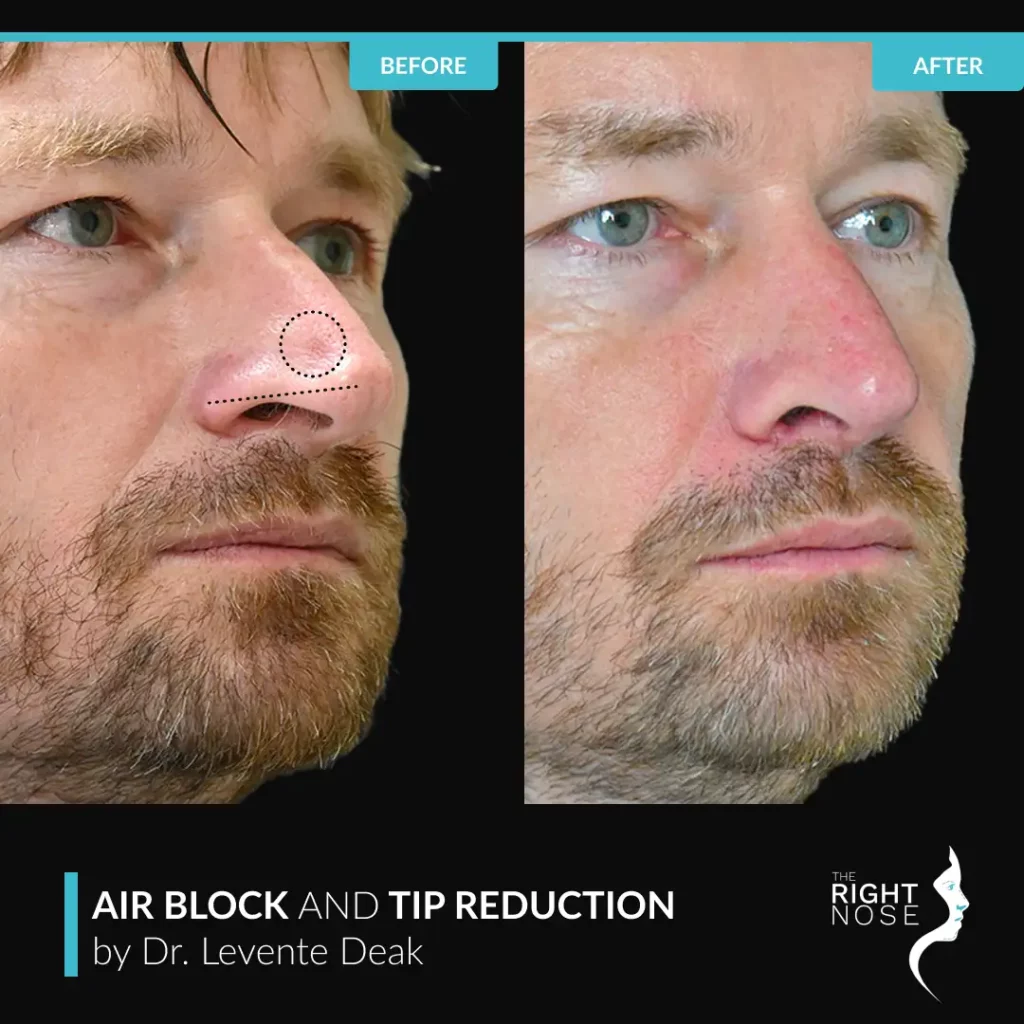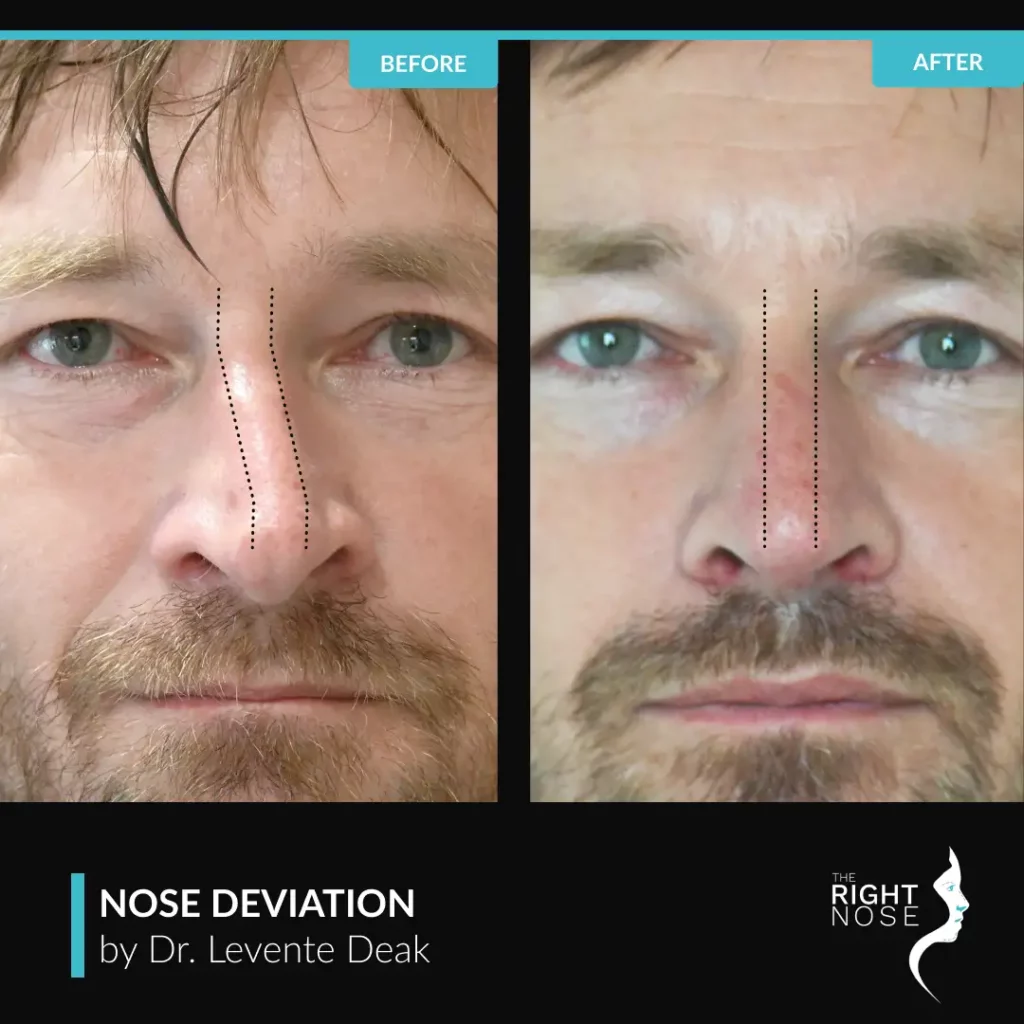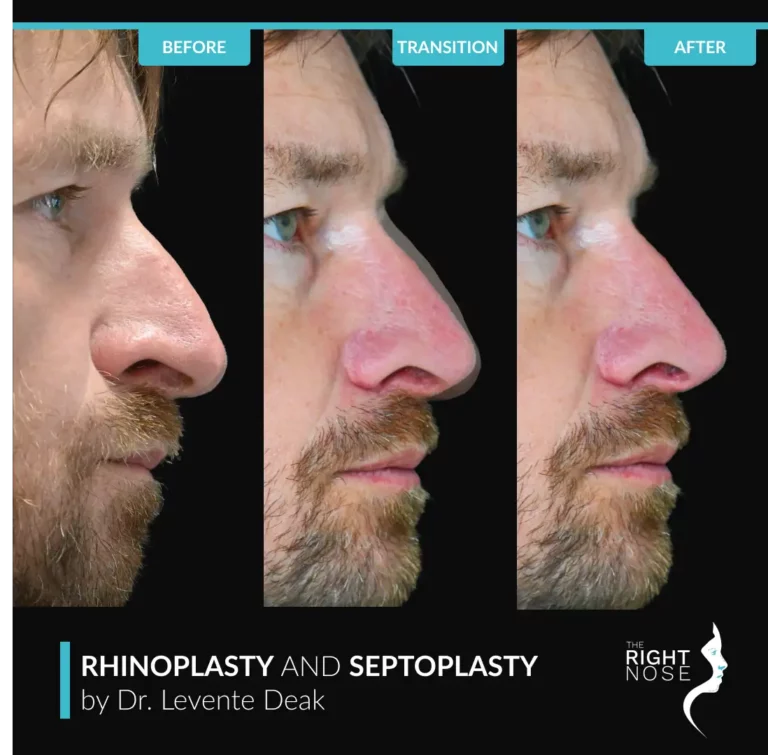What is the Difference Between Septorhinoplasty and Rhinoplasty?
What is the Difference Between Septorhinoplasty and Rhinoplasty?
Straighten, Sculpt, or Both? The Nose Surgery Guide!
When considering nasal surgery, it’s essential to understand the difference between rhinoplasty and Septorhinoplasty. While both procedures enhance the nose’s appearance, septorhinoplasty also addresses functional concerns like breathing difficulties caused by a deviated septum. Rhinoplasty primarily focuses on reshaping the nose for aesthetic purposes, whereas septoplasty operation combines cosmetic improvements with structural corrections to improve airflow.
Dr Levente Deak specializes in both procedures, offering tailored treatments to enhance nasal function and appearance, ensuring natural-looking results that align with each patient’s needs.
What is the difference between Septorhinoplasty and Rhinoplasty?
Nasal surgery can be carried out either for cosmetic or functional reasons, or may be a combination of both. If you are considering nasal surgery, you may have come across two commonly used terms—rhinoplasty and septorhinoplasty. While both procedures reshape the nose, septorhinoplasty also corrects structural issues inside the nose, such as a deviated septum, to improve breathing. Understanding the difference between these surgeries can help you make an informed decision about which procedure is right for you.
What is Rhinoplasty?
Rhinoplasty, often referred to as a nose job, is a surgical procedure designed to alter the shape and size of the nose. It is typically performed for aesthetic purposes, allowing patients to achieve a more balanced and symmetrical facial appearance. However, in some cases, rhinoplasty may also help correct minor functional issues, such as minor breathing difficulties or nasal asymmetry caused by injury.
Remember that Rhinoplasty will not improve your airway, might even reduce it if too much reduction is done.
Types of Rhinoplasty
- Open Rhinoplasty: This method involves creating an incision on the the strip of tissue between the nostrils (columella) to render better visibility for complex reshaping.
- Closed Rhinoplasty: This method creates incisions inside the nostrils, leaving no visible scars, typically used for minor adjustments.
What is Septorhinoplasty?
Septorhinoplasty is a more comprehensive procedure that combines rhinoplasty with septoplasty, a surgery that corrects a deviated septum. The septum is the cartilage and bone inside the nose that separates the nostrils. If it is misaligned, it can cause breathing difficulties, nasal congestion, snoring, and frequent sinus infections.
The main indication for septorhinoplasty is airway block due to deformed shape. Mostly the septum deviation can be seen on the surface, usually old sport trauma or just born genetic. Not tomention, the shape improves with function together.
What happens during a Septorhinoplasty operation?
During the procedure, the surgeon makes incisions inside the nose (or externally if necessary) to access the nasal septum. The deviated portions are repositioned or removed to create a straighter airway.
Simultaneously, cosmetic enhancements are made to refine the nose’s appearance.
Septoplasty vs. Septorhinoplasty: Key Differences
- Septoplasty corrects the internal structure of the nose to improve breathing but does not alter its external shape.
- Septorhinoplasty combines septoplasty with cosmetic changes to enhance the nose’s appearance while also improving function.


Recovery After Septoplasty and Septorhinoplasty
Septoplasty Recovery Timeline
- First Few Days: Expect nasal congestion, mild pain, and slight bleeding.
- 1 Week: Nasal packing (if used) is removed; breathing improves gradually.
- 2 Weeks: Swelling and bruising start to subside.
- 1 Month: Most swelling reduces, and patients can resume normal activities.
- 3-6 Months: Complete internal healing occurs.
How long does bleeding last after Septoplasty?
Mild bleeding is common for the first 24-48 hours. Patients are advised to avoid strenuous activities, bending over, and nose-blowing during this time to prevent excessive bleeding.
Septorhinoplasty cost with insurance coverage
The cost of septorhinoplasty varies depending on location, surgeon experience, and complexity. However, if the surgery is performed to correct breathing issues caused by a deviated septum, insurance may incur the functional portion of the surgery.
Insurance Considerations
- Covered by Insurance: The septoplasty portion is often covered if medically necessary.
- Not Covered by Insurance: The cosmetic rhinoplasty portion is typically considered elective and must be paid out of pocket.
- Partial Coverage: Some insurance providers may cover part of the procedure if breathing issues are a major concern.
External Septorhinoplasty: When is it Needed?
An external septorhinoplasty (also called open septorhinoplasty) involves making an incision on the columella. This approach is used for cases requiring significant structural corrections, such as severe deviations, trauma, or complex reshaping. While this method may result in a small scar, it offers greater surgical precision.
Septoplasty Experience: What to Expect?
Patients undergoing septoplasty often report improved breathing, reduced snoring, and fewer sinus infections. The procedure is usually performed under the influence of general anesthesia and takes about 1-2 hours. Most patients go home the same day.
Common Post-Surgery Experiences:
- Mild pain and discomfort for a few days
- Nasal congestion due to swelling
- Slight bleeding for the first few days
- Gradual improvement in breathing within a few weeks

Septoplasty Failure Symptoms: Signs you may need Revision Surgery
While septoplasty has a high success rate, complications can occur.
Some failure symptoms include:
- Persistent nasal blockage despite surgery
- Recurrent sinus infections
- Difficulty breathing through one or both nostrils
- Noticeable septum deviation remains
- Excessive scarring causing nasal obstruction
If symptoms persist after 3-6 months, a revision procedure may be necessary.
Septoplasty Healing Stages: A Timeline
Week 1:
- Nasal packing (if used) is removed.
- Swelling and bruising peak, then gradually decrease.
Weeks 2-4:
- Significant reduction in swelling.
- Breathing continues to improve.
Months 1-3:
- Most of the healing is complete.
- Minor residual swelling may persist but isn’t noticeable.
6 Months – 1 Year:
- Full internal healing occurs.
- Final results are visible.
Consult Dr Levente Deak for Septorhinoplasty Expertise in Dubai
Both rhinoplasty and septorhinoplasty offer valuable benefits depending on the patient’s needs. If you are primarily concerned with cosmetic changes, a rhinoplasty may be sufficient. However, if you struggle with breathing issues due to a deviated septum, septorhinoplasty may be the best solution, as it improves both function and appearance.
Understanding the procedures, recovery timelines, costs, and potential risks can assist you in making an informed decision. If you are considering nasal surgery, consulting with an experienced specialist like Dr. Levente Deak can help you determine the best approach for achieving your desired results.





